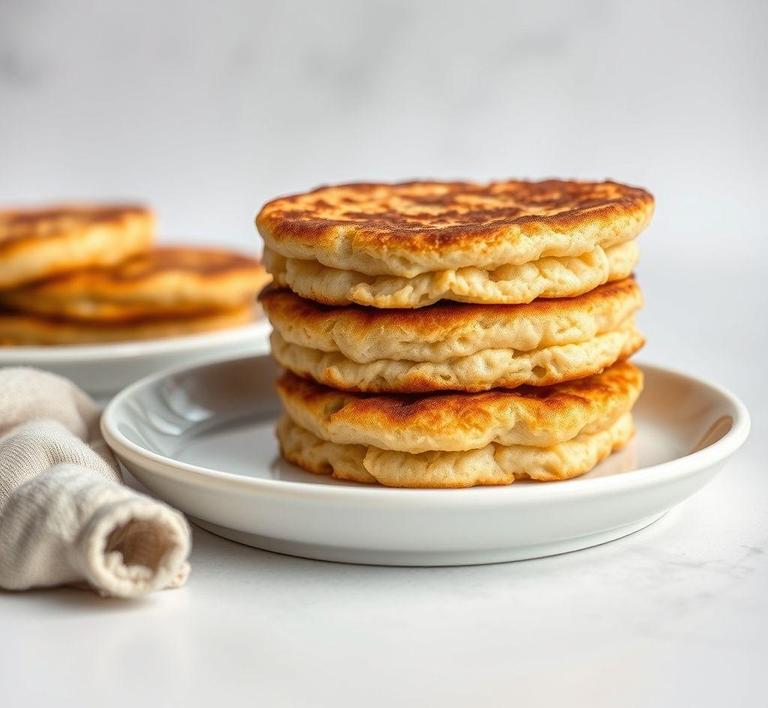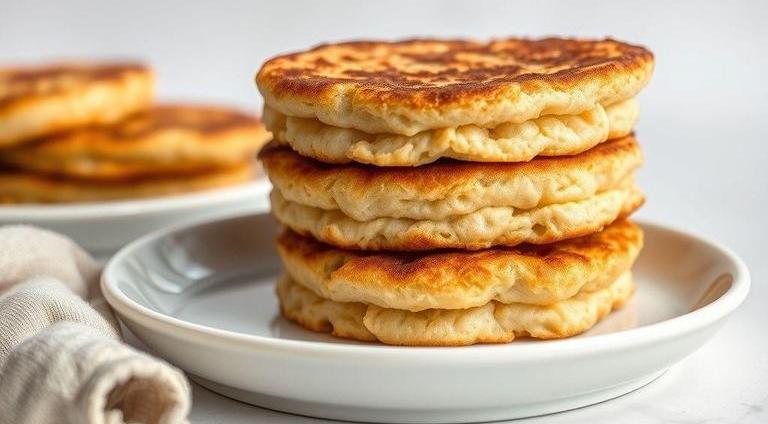- You are here:
- Home »
- James Martin Recipes
- » James Martin’s Crumpets Recipe
James Martin’s Crumpets Recipe
Crumpets are the quintessential British teatime treat-soft, springy, and riddled with holes that eagerly soak up butter, jam, or honey. James Martin, a celebrated British chef known for his rustic charm and mastery of comfort food, brings his signature touch to this classic. His version of crumpets is true to tradition, embracing the hallmark texture-a crisp, golden-brown bottom with a spongy, airy top pockmarked with holes perfect for trapping melted butter.
Unlike pancakes or muffins, crumpets are cooked on a griddle and rely heavily on yeast to produce their iconic texture. James Martin’s recipe leans into old-school techniques with modern finesse, ensuring a consistent rise and characteristic tang.
The result?
A homemade delight that dances the line between nostalgic and gourmet.
James Martin’s Crumpets Recipe
Ingredients Needed

James Martin’s crumpets require only a handful of pantry staples, but precision and patience elevate them to café-level quality. Here’s what you’ll need:
- 450g strong white bread flour – Provides the protein structure needed for the crumpets’ signature chew and rise.
- 1 tsp caster sugar – Feeds the yeast and adds a subtle hint of sweetness.
- 1 x 7g sachet of fast-action dried yeast – The life-force behind the airy texture and bubbly surface.
- 1 tsp salt – Balances the flavors and strengthens the dough.
- 450ml warm milk (or half milk, half water) – Encourages the yeast to activate while adding richness.
- 150ml warm water – Helps loosen the batter to the right consistency.
- ½ tsp bicarbonate of soda – Introduced later in the process to assist with bubble formation during cooking.
- Butter – For greasing and serving.
Equipment Needed
While simple in concept, crumpets require a few key tools to get that flawless, café-style finish:
- Large mixing bowl – To combine and rest the batter.
- Whisk – To incorporate air and blend the ingredients smoothly.
- Measuring jug – Essential for accuracy with liquids.
- Crumpet rings (metal cooking rings) – To shape the crumpets into their classic thick rounds. (Egg rings or cookie cutters can work in a pinch.)
- Non-stick frying pan or flat griddle – For even cooking and that perfect golden base.
- Spatula – To flip or lift crumpets off the heat.
- Tea towel – To cover the batter during resting.
Step-by-Step Guide To Make James Martin’s Crumpets
-
Mix the Dry Ingredients:
In a large bowl, combine the flour, sugar, salt, and yeast. Keep the yeast on one side of the bowl and salt on the other-they don’t play nicely until moistened. -
Add Warm Liquids:
Gradually pour in the warm milk and water. Whisk vigorously until the batter is smooth and lump-free. The consistency should be similar to a thick pancake batter. -
Let it Rise:
Cover the bowl with a clean tea towel and leave it in a warm spot for 1 hour. The batter will double in size and bubble up beautifully. -
Add Bicarbonate of Soda:
Mix the bicarbonate of soda into 2 tbsp of warm water and stir into the risen batter. This encourages additional bubbling-key for those signature holes. -
Prepare the Pan and Rings:
Heat a non-stick pan or griddle over low-medium heat. Grease the crumpet rings and place them in the pan. Add a little butter to coat the base of the rings. -
Spoon and Cook:
Fill each ring about halfway with batter. Let them cook gently for about 6-8 minutes until the tops are set and riddled with holes. If the bottoms begin to brown too quickly, reduce the heat. -
Flip or Finish:
For a crispier top, gently flip the crumpets for 1 minute. Or, if you prefer a soft top (like shop-bought crumpets), skip the flip and just pop them out of the rings once firm. -
Serve:
Toast lightly, slather with butter, and enjoy with your favorite spread-golden syrup, clotted cream, or marmalade.
Mastering The Recipe: Tips And Tricks
-
Batter Consistency is Crucial:
The batter should be pourable but thick enough to hold shape in the rings. Too thin and it’ll run out; too thick and you’ll lose the bubbles. -
Warmth Matters:
Yeast is finicky-aim for liquids around 37°C (body temperature). Too hot and you’ll kill it; too cold and it’ll snooze. -
Don’t Rush the Rise:
Give your batter the full hour. You want it bubbling and slightly stretchy. -
Use Proper Rings:
Metal rings conduct heat well and maintain the perfect shape. Silicone rings are too floppy, and freeform crumpets won’t develop height. -
Low and Slow:
Cooking crumpets slowly ensures even bubbling and avoids burnt bottoms. Patience really does pay off. -
Rest Before Toasting:
Once cooked, let the crumpets cool on a wire rack before toasting. They toast best once they’ve firmed up slightly.
James Martin’s crumpets are more than a breakfast dish-they’re an experience. The alchemy of simple ingredients, old-world technique, and a touch of patience transforms everyday elements into something truly special. Whether you’re aiming to impress at brunch, relive nostalgic teatimes, or simply enjoy the meditative art of slow cooking, this recipe delivers.
There’s something deeply satisfying about crafting a food so steeped in tradition, and biting into a freshly toasted crumpet-its porous top absorbing butter like a sponge-is an unmatched joy. Once you’ve mastered it, you may never go back to store-bought again.
Simple Twists On James Martin’s Crumpets Recipe
James Martin’s crumpets are a tribute to traditional British baking-chewy, golden, and riddled with those signature crater-like holes that soak up butter like a sponge.
But once you’ve mastered the original, why not get creative?
Here are some simple yet delightful twists that turn a humble crumpet into a gourmet adventure:
-
🔹 Sourdough Starter Base:
Swap half the yeast in the original recipe for a spoonful of sourdough starter. This adds depth, a hint of tang, and an even chewier texture. Let it ferment overnight in the fridge for more flavor complexity. -
🔹 Buttermilk Upgrade:
Replace some of the warm milk or water with buttermilk. This gives the batter a slight tang and makes the crumpets ultra tender on the inside while still crisping beautifully on the outside. -
🔹 Herb & Cheese Infusion:
For savory crumpets, fold in a handful of finely chopped chives, rosemary, or thyme along with grated mature cheddar just before the final proof. These make excellent bases for eggs benedict or hearty breakfast sandwiches. -
🔹 Sweet Vanilla & Cardamom Notes:
Add a touch of vanilla extract and a pinch of ground cardamom to the batter for a lightly spiced, aromatic version. Serve with honeyed ricotta and roasted figs for a show-stopping brunch. -
🔹 Wholemeal or Rye Touch:
Sub out up to one-third of the white flour for wholemeal or rye flour for a nuttier, heartier crumpet that feels rustic and robust. Perfect paired with farmhouse butter and marmalade.
How To Properly Store Leftovers
Crumpets are best enjoyed fresh off the griddle, but if you’ve made a big batch-or you’re lucky enough to have leftovers-proper storage is key to preserving their pillowy interior and crisp surface.
-
🌡 Room Temperature (Short-Term Storage)
- Let crumpets cool completely on a wire rack (important to prevent sogginess from steam).
- Store in an airtight container or a zip-lock bag with a paper towel to absorb moisture.
- They’ll stay fresh for up to 2 days at room temp.
-
❄️ Refrigeration (Not Ideal)

- While refrigeration is a common instinct, it can actually dry out crumpets. Only refrigerate if your environment is especially humid.
- Wrap in foil or place in a sealed container, and reheat gently in a toaster to restore texture.
-
🧊 Freezing (Best For Long-Term)
- Cool the crumpets fully.
- Place parchment paper between each one, then store in a freezer-safe bag or container.
- Freeze for up to 2 months.
- Reheat from frozen in the toaster or oven-no thawing necessary!
Pro Tip: Lightly toasting crumpets before freezing ensures a crispier finish when reheated.
What To Eat With James Martin’s Crumpets?
Crumpets are culinary chameleons. They’re just as comfortable on a cozy breakfast table as they are as a canape base at a dinner party. Here are ways to dress them up or down for every occasion:
-
🧈 Classic & Cozy
- Lashings of salted butter that pool into the holes.
- A drizzle of golden syrup or local honey.
- Homemade jam-raspberry, apricot, or blackberry-pairs wonderfully with the toasty flavors.
-
🍳 Hearty & Savory
- Poached eggs with hollandaise atop toasted crumpets for an elevated brunch.
- Smoked salmon, cream cheese, and dill-a luxurious afternoon tea offering.
- Sautéed mushrooms with garlic and thyme, finished with a shaving of parmesan.
-
🍫 Sweet & Indulgent
- Chocolate hazelnut spread with sliced bananas and a sprinkle of sea salt.
- Warm apples sautéed in cinnamon butter, finished with a dollop of crème fraîche.
- A slather of clotted cream and strawberry preserves-a nod to a Cornish cream tea.
-
🧀 Gourmet & Unexpected
- Blue cheese and fig chutney on toasted crumpets make an exquisite appetizer.
- Brie and cranberry under the grill until bubbling.
- Grilled goat cheese with a drizzle of balsamic glaze.
Conclusion
James Martin’s crumpet recipe is a springboard into a delicious world where texture meets tradition and flavor knows no bounds. Whether you stay true to the classic version or play with daring flavors and combinations, crumpets offer a blank canvas begging for creativity. Properly stored, they can be a quick toast away from a delightful breakfast or a standout snack.
So next time you whip up a batch, don’t stop at butter-think bold, think sweet, think savory. Your crumpet journey has only just begun.
FAQs
What Ingredients Are Essential In James Martin’s Crumpets Recipe?
James Martin’s crumpets rely on a few pantry staples to achieve their iconic texture and taste. The core ingredients include strong white bread flour, dried yeast, warm milk, warm water, sugar, salt, and bicarbonate of soda.
The yeast is essential for that airy, holey texture, while the bicarb helps with rising and structure during the cooking process. A good quality non-stick pan or crumpet rings can also make a big difference in achieving the right shape and consistency.
How Long Should The Crumpet Batter Rest Before Cooking?
In James Martin’s version, the batter needs to rest for about an hour to allow the yeast to ferment and create those characteristic bubbles. After mixing the wet and dry ingredients, the batter is left in a warm place, covered with a cloth or cling film. This resting time is crucial-it lets the yeast do its magic, giving the crumpets that spongy interior and signature nooks and crannies on top.
How Do You Know When The Crumpets Are Ready To Be Flipped Or Removed From The Ring?
Timing and observation are key. When cooking James Martin’s crumpets, you’ll know they’re ready to be removed from the ring or flipped when the tops have set and are covered in small holes.
This usually takes 5-7 minutes on a medium heat. If the tops are still wet or collapsing, they need a bit more time. Once they’ve firmed up, you can optionally flip them for 30 seconds to lightly brown the tops, although traditionally, crumpets are just cooked on one side.
